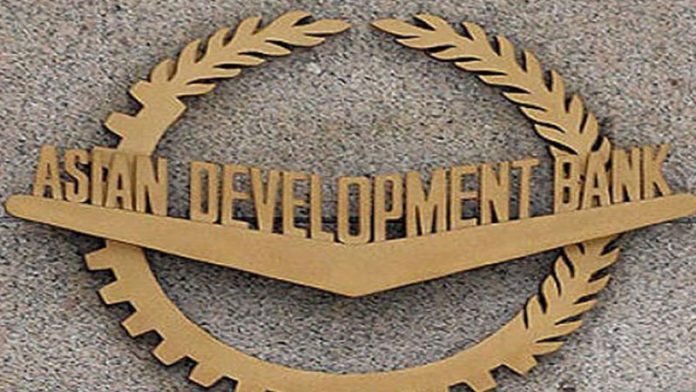The Asian Development Bank (ADB) has revised Pakistan’s GDP growth forecast for the fiscal year 2024 down to 1.9 percent (two percent in April), while inflation is forecast at 25 percent, sharply higher than the earlier 15 percent projection, saying downside risks to the outlook remain exceptionally high.
The bank in its report, “Asian Development Outlook,” stated that amid the upcoming election season, persistent political instability will remain a key risk to implementing reform toward growth stabilisation, the restoration of confidence, and sustainable debt.
Disbursement from multilateral and bilateral partners would remain crucial for reserve accumulation, exchange rate stability, and improved market sentiment.
The bank also revised Pakistan’s GDP growth estimate for fiscal year 2023 down to 0.3 per cent (0.6 per cent forecast in April), because political instability and floods affected the economy. In Pakistan, inflation is estimated to have accelerated to 29.2 per cent in fiscal year 2023, faster than April’s 27.5 per cent forecast, the report added.
In Pakistan, growth is forecast at 1.9 per cent in fiscal year 2024, assuming continued implementation of reforms and supportive macroeconomic policies, recovery from flood-induced supply shocks, and improving external conditions.
Political stability following general elections later this year, if achieved, will boost business confidence, as will a new standby arrangement agreed with the International Monetary Fund (IMF) to support economic stabilisation and rebuild fiscal buffers.
The economy’s near-term prospects will heavily rely on progress under the economic adjustment program. The program aims to stabilise the economy and rebuild buffers for domestic and external balance, thereby providing a foundation for a possible successor programme under the new government expected to be elected in the first quarter of calendar year 2024, the bank added.
The program involves fiscal consolidation, monetary tightening, and a return to a market-determined exchange rate, as well as structural reforms in energy, state-owned enterprises, banking, and climate resilience. The economy is projected to recover modestly in fiscal year 2024 with base effects from the post-flood recovery. Uncertainty will linger, though, and stabilisation measures will limit the growth of demand.
It further stated that fiscal and monetary tightening will crimp demand, as will inflation staying in double digits. On the other hand, implementation of the economic adjustment program and a likely smooth general election should boost confidence, while the easing of import controls should support investment as fiscal tightening restrains public consumption. On the output side, better weather conditions will enable an increase in the area under cultivation and in yields, supporting recovery in agriculture.
In turn, the recovery of farm output will feed through to industry, which will also benefit from the increased availability of critical imported inputs. The recovery of output will enable exports to pick up, although imports will grow much faster, due to pent-up demand.
However, the downside risks are significant, including from global price shocks and slower global growth. Downside risks to the outlook remain exceptionally high. On the external front, tighter global financial conditions and potential supply chain disruptions from any escalation of the Russian invasion of Ukraine will weigh on the economy.
The report noted that fiscal tightening will come from raising revenues and containing spending. The fiscal year 2024 budget targets a primary surplus of 0.4 per cent of GDP and an overall deficit of 7.5per cent of GDP, gradually declining over the medium term.
Tax revenues are programmed to hit 10.3 per cent of GDP in fiscal year 2024. Provincial spending will be cut by 0.4 per cent of GDP and spending on defense and energy subsidies will be limited, while protecting priority social and development outlays. The government has committed to granting no further tax amnesties or issuing new tax preferences or exemptions.
Despite continued monetary tightening, disinflation faces headwinds. Inflation is expected to ease in fiscal year 2024, as base-year effects set in, food supply normalises, and inflation expectations moderate. In addition, the central bank will likely raise the policy rate from the 22 per cent it set in July 2023 to gradually reduce inflation to its medium-term target of 5per cent–7per cent.
The central bank has agreed to achieve positive real interest rates, refrain from introducing new refinancing schemes, and contain refinancing credits. However, significant inflationary pressures remain.
The report further stated that sharp increases in petroleum, electricity, and gas tariffs are envisaged under the programme. As import and exchange rate controls are eased, the rupee could further weaken, raising the cost of imported goods.
El Niño and the continuing Russian invasion of Ukraine could disrupt supplies and raise prices of wheat, rice, and other basic foodstuffs. Hence, inflation will likely remain high at about 25 per cent in fiscal year 2024, significantly higher than projected earlier in ADO April 2023.
Easing import and exchange rate controls will have competing effects on the current account balance and reserves. Imports should increase as economic activity recovers and as businesses find it easier to import inputs. But exports should also recover, despite slower global growth, on greater availability of inputs, improved farm output, and a more competitive rupee.
On balance, the current account deficit is projected to increase to about 1.5per cent of GDP in fiscal year 2024. Despite the larger deficit, international reserves should grow.
The new program with the IMF has improved the prospects for multilateral and bilateral financing, while a more market-determined exchange rate is expected to stabilise the currency market and encourage remittance inflows through official channels, the report noted.
Forecasts for sub-regional inflation are revised up from April to 8.6 per cent in 2023 and 6.6 per cent in 2024. The revision for this year mainly reflects higher expected inflation in Pakistan and India.
Average inflation in Pakistan will soar from 12.2per cent in fiscal year 2022 to 29.2 per cent on higher food prices caused by supply shortages, continued currency depreciation, import restrictions, and fiscal stimulus for post-pandemic recovery. In fiscal year 2023, the economy was buffeted by severe floods, global price shocks, and political instability.
Expansionary fiscal and monetary policy hit their limits. Growth fell, inflation jumped, the Pakistan rupee weakened, and international reserves shrank. In response, fiscal and monetary policy have been tightened.
Adherence to an economic adjustment program through April 2024 will be critical for restoring stability and the gradual recovery of growth, which is projected to reach a moderate 1.9 per cent in fiscal year 2024, with price pressures remaining elevated.
Severe shocks and policy slippage raised economic volatility in fiscal year 2023. Massive floods hurt farm output and food stocks, jacking up food prices. Political unrest reduced investor confidence and consumer spending. High global prices for food and fuel cut purchasing power and raised import costs.
Slower global growth curbed exports and global monetary tightening reduced financing flows. Nevertheless, expansionary policies were continued, including large fuel and electricity subsidies. Due to missed targets under an IMF extended fund facility, IMF financing ceased and flows from bilateral and multilateral sources also slowed.
Tight foreign exchange controls reduced imports, which curtailed production due to the scarcity of critical inputs. Consequently, real GDP stagnated, and inflation jumped.
The report noted that ad hoc import controls cut the current account deficit but at some cost. The current account deficit shrank by 85per cent in fiscal year 2023 to $2.6 billion (or 0.7per cent of GDP) from $17.5 billion (or 4.7per cent of GDP) in 2022.
Administrative efforts to control the exchange rate led to the emergence of a parallel foreign exchange market with a substantial premium over the official exchange rate. This, in turn, led to a further tightening of foreign currency liquidity in the interbank market by encouraging the use of the parallel market for inward remittances and proceeds from service exports. Consequently, recorded workers’ remittances fell by $4.3 billion to $27 billion in fiscal year 2023.
Despite a sharply narrowed current account deficit, international reserves plunged. Net international reserves fell by more than half during fiscal year 2023, to $4.5 billion from $9.8 billion at the end of fiscal year 2022, reflecting a 40per cent larger outflow for external debt repayments.
In July 2023, after Pakistan reached an agreement with the IMF, the IMF disbursed $1.2 billion while Saudi Arabia and the United Arab Emirates lent a total of $3 billion, raising foreign reserves to $8.2 billion. The fiscal deficit remained high on weak tax collection and higher interest outlays.
The target fiscal year 2023 budget deficit was raised from 4.5per cent of GDP to 6.9per cent of GDP, to allow for flood relief and rehabilitation. The actual deficit was higher, 7.7per cent of GDP, little changed from 7.9per cent in fiscal year 2022.
The primary balance registered a deficit of 0.8per cent of GDP, also above the revised target, although less than the 3.1per cent deficit in fiscal year 2022.
Although tax revenues grew by 15.7per cent, they fell to 9.2per cent of GDP in fiscal year 2023 from 10.1per cent of GDP in fiscal year 2022, reflecting poor collections of sales taxes and customs duties from the economic slowdown and contraction in imports and industrial output.
The decline would have been even larger if direct taxes had not risen by 0.4per cent of GDP, thanks to tax policy measures enacted through a mini-budget revision in February 2023.
Nontax revenues increased to 2.1per cent of GDP from 1.9per cent a year earlier, helped by an increase in the petroleum development levy to the statutory upper limit. Because of the large fiscal deficit, the weaker rupee, and slow growth, public debt rose to 74.3per cent of GDP in fiscal year 2023, above the 73.9per cent of GDP in FY2022.
External debt, despite a decline in dollar terms due to scarce external finance, increased to about 32.1per cent of GDP from 30.5per cent of GDP in fiscal year 2022, reflecting the large exchange rate depreciation. The IMF’s latest assessment concluded that public debt remains sustainable, assuming steadfast implementation of the adjustment programme, the bank added.
























Cyber Genie Hack Pro, has the best legal cryptocurrency investigators and ethical hackers on the internet. The team is excellent at conducting extensive investigations into anything related to cyber fraud and data recovery. They are well-advanced and their expertise in recovering stolen Bitcoin is what amazes me. I came to find out about them through multiple referrals I have read on the internet, and when they handled my task, I was wowed at how fast they got my stolen Bitcoin repossessed from a guy whom I turned down his advances just for him to go hack my devices and steal my funds and other private data. I will keep telling the world about Cyber Genie. Reach their customer service via:
( Cybergenie(@)Cyberservices. com )
(WhatsAPP +1 (252) 512-0391)